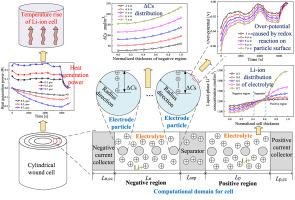锂离子电池内部动态极化效应、锂离子分布不均匀耦合产热特性与电池芯设计
IF 5
2区 工程技术
Q1 ENGINEERING, MECHANICAL
International Journal of Thermal Sciences
Pub Date : 2025-10-11
DOI:10.1016/j.ijthermalsci.2025.110366
引用次数: 0
摘要
电极结构尺寸包括负极体积分数εs,n、正极体积分数εs,p、负极颗粒半径rp,n和正极颗粒半径rp,p是锂离子电池的关键设计参数。为了评估电极结构尺寸对锂离子电池发热、过电位极化效应和锂离子扩散的影响,在充电速率1C、环境温度25℃的条件下,建立了电池设计的电化学-热耦合模型进行了数值研究。结果表明:随着电极体积分数或颗粒半径的增大,总发热量qtot增大;随着εs的增大,充电中后期负极过电位η峰增大,正极过电位η峰减小。在rp,n = 7 μm时,负极的η值比rp,n = 3 μm时增大了150%。rp,p = 5.5 μm时正极的η值比rp,p = 1.5 μm时增大了240%。增大εs,n分别增大和减小负极电解质和正极电解质的锂离子浓度梯度梯度。在增加εs的同时,p增加了整个细胞的梯度。当εs,n或εs,p由0.3增加到0.7时,电极颗粒表面与中心之间的锂离子浓度差Δcs分别减小35%或60%。rp,n增大或rp,p减小时,负极Δcs增大,正极Δcs减小。在充电速率为3C、电池初始温度为35℃的条件下,对考虑电池热管理系统的锂离子电池进行了数值研究。当工质温度降低或换热系数增大时,锂离子扩散系数降低,氧化还原反应速率降低,qtot、η、品位和Δcs均增大。本文章由计算机程序翻译,如有差异,请以英文原文为准。

Dynamic polarization effect and lithium-ions distribution non-uniformity coupling heat generation characters inside lithium-ion cell with battery cell design
Electrode structure sizes including negative electrode volume fraction εs,n, positive electrode volume fraction εs,p, negative electrode particle radius rp,n and positive electrode particle radius rp,p are key design parameters of lithium-ion cell. To assess the impacts of electrode structure sizes on heat generation, polarization effect expressed by over-potential and lithium-ions diffusion in lithium-ion cell, an electrochemical-thermal coupling model with battery cell design was presented for a numerical investigation at charge rate 1C and ambient temperature 25 °C. The results indicate that when volume fraction or particle radius of electrode increases, total heat generation power qtot increases. Increasing εs,p increases over-potential η peak of negative electrode, while decreases η of positive electrode in the middle and late stage of charge. η of negative electrode at rp,n = 7 μm increases by 150 % compared to that at rp,n = 3 μm. η of positive electrode at rp,p = 5.5 μm increases by 240 % compared to that at rp,p = 1.5 μm. Increasing εs,n increases and decreases respectively the lithium-ion concentration gradients gradce of negative electrolyte and positive electrolyte. While increasing εs,p increases gradce in the whole cell. When εs,n or εs,p increases from 0.3 to 0.7, lithium-ion concentration difference between surface and center of electrode particle Δcs decreases by 35 % or 60 %. If rp,n increases or rp,p decreases, Δcs of negative and positive electrodes increases and decreases respectively. Lithium-ion cell considering battery thermal management system was numerically studied at charging rate of 3C and initial cell temperature of 35 °C. When working medium temperature decreases or heat transfer coefficient increases, lithium-ion diffusion coefficient and redox reaction rate decrease, thus qtot, η, gradce and Δcs all increase.
求助全文
通过发布文献求助,成功后即可免费获取论文全文。
去求助
来源期刊

International Journal of Thermal Sciences
工程技术-工程:机械
CiteScore
8.10
自引率
11.10%
发文量
531
审稿时长
55 days
期刊介绍:
The International Journal of Thermal Sciences is a journal devoted to the publication of fundamental studies on the physics of transfer processes in general, with an emphasis on thermal aspects and also applied research on various processes, energy systems and the environment. Articles are published in English and French, and are subject to peer review.
The fundamental subjects considered within the scope of the journal are:
* Heat and relevant mass transfer at all scales (nano, micro and macro) and in all types of material (heterogeneous, composites, biological,...) and fluid flow
* Forced, natural or mixed convection in reactive or non-reactive media
* Single or multi–phase fluid flow with or without phase change
* Near–and far–field radiative heat transfer
* Combined modes of heat transfer in complex systems (for example, plasmas, biological, geological,...)
* Multiscale modelling
The applied research topics include:
* Heat exchangers, heat pipes, cooling processes
* Transport phenomena taking place in industrial processes (chemical, food and agricultural, metallurgical, space and aeronautical, automobile industries)
* Nano–and micro–technology for energy, space, biosystems and devices
* Heat transport analysis in advanced systems
* Impact of energy–related processes on environment, and emerging energy systems
The study of thermophysical properties of materials and fluids, thermal measurement techniques, inverse methods, and the developments of experimental methods are within the scope of the International Journal of Thermal Sciences which also covers the modelling, and numerical methods applied to thermal transfer.
 求助内容:
求助内容: 应助结果提醒方式:
应助结果提醒方式:


